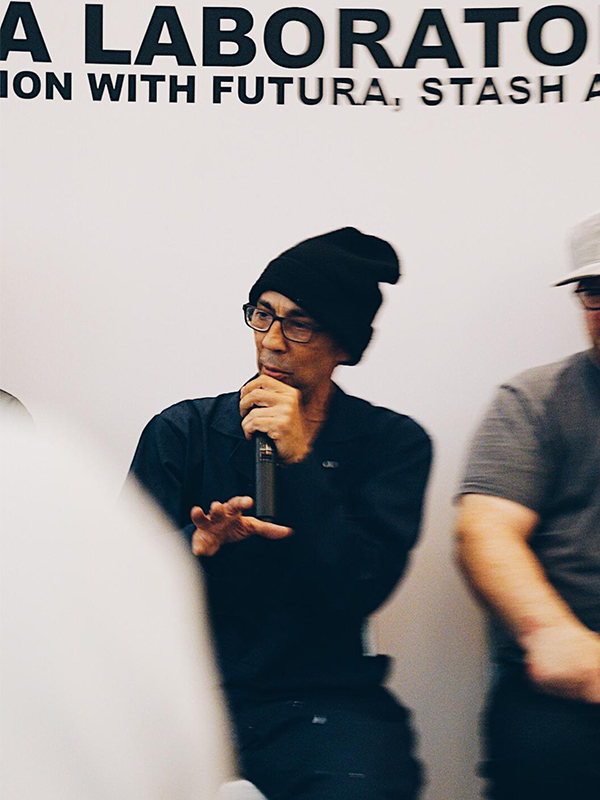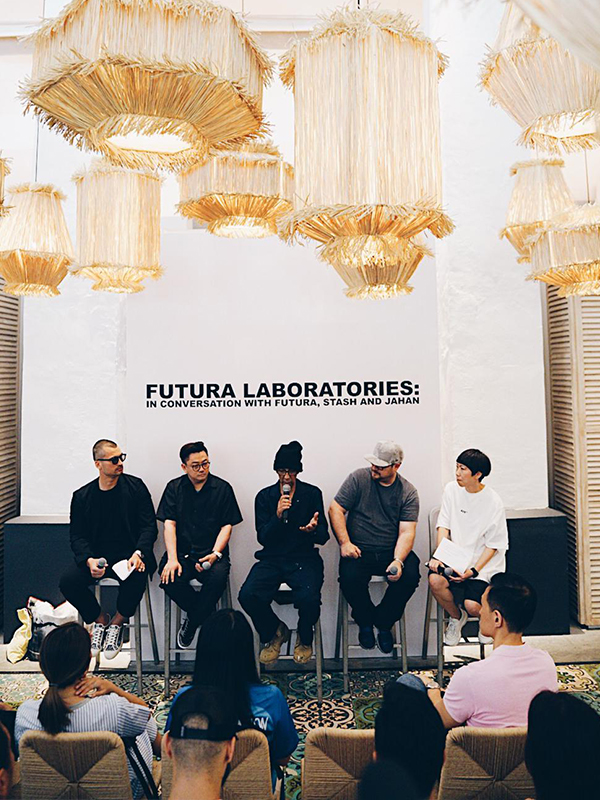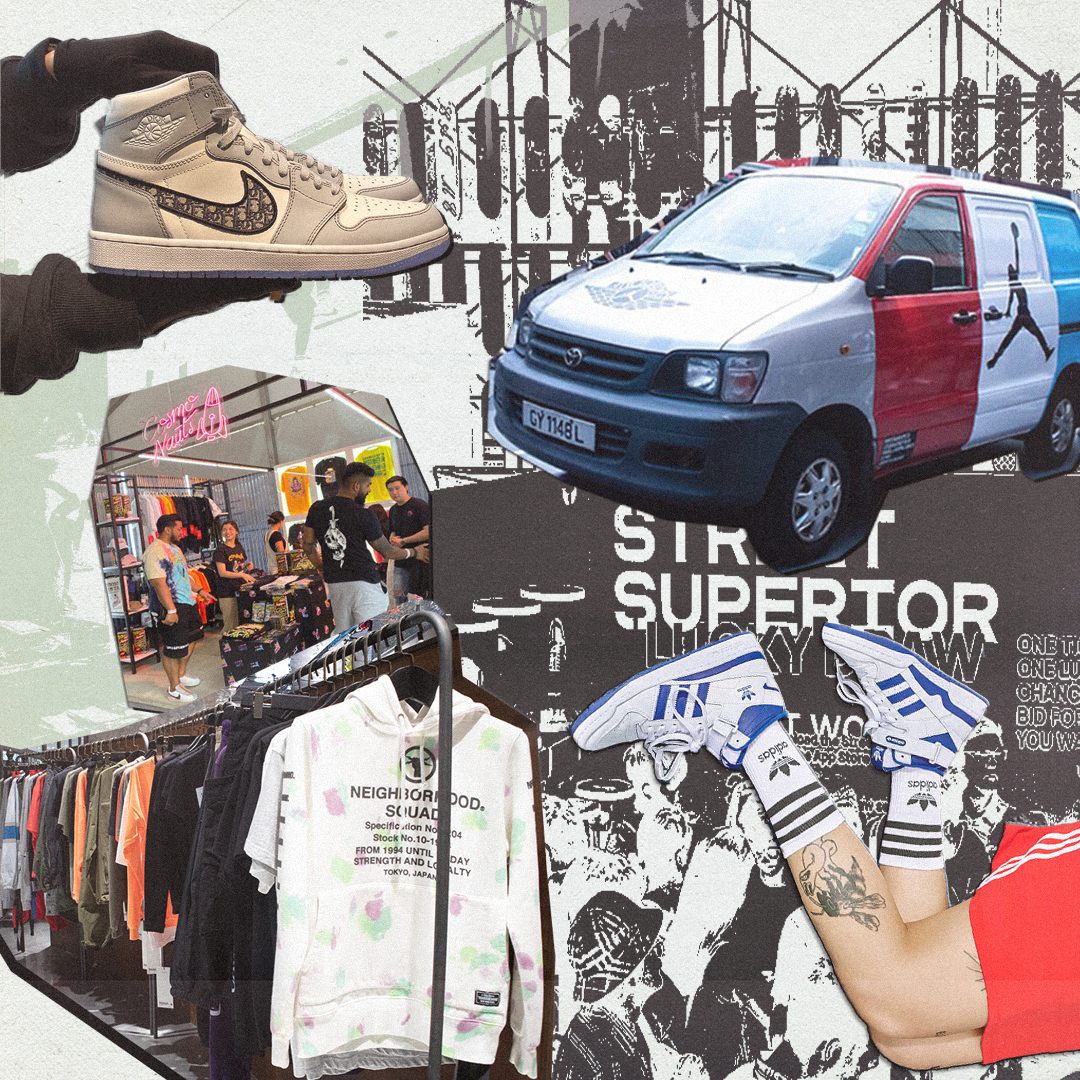Sign up for trending news and first dibs
“I hope to keep going for another quarter of a century”: An interview with legendary street artist Futura
“I hope to keep going for another quarter of a century”: An interview with legendary street artist Futura
If there’s one name in street art that has reached rockstar status, it has to be Leonard McGurr – the man, the myth, the legend.

Formerly known as Futura 2000, this legendary street artist was part of an ensemble of famous graffiti artists who pioneered the movement in New York back in the 70s and 80s. Tracing back his rise to fame, we talked about transitioning from the streets to galleries and continuous growth as a creative in this full Futura interview.
Today, street art has conquered public trains, walls in war-torn countries, and even art galleries all over the world. We speak to the man himself, who has continuously created art for over 40 years and recently made his Southeast Asian debut in Singapore with his art exhibition Constellation. Check out the full Futura interview below.
Congratulations on your debut solo exhibition in Southeast Asia. You’ve been to Singapore before this. What do you like about the country?
I love the tropical climate and honestly the sense of order and extreme cleanliness here. The quality of life looks to be very good too. I’ve been all over and Singapore is completely different in a sense that it seems to have the best of everything in a way – there’s the classic historical side of Singapore and then you have the modernization of it. I remember coming here in the 70s as a teenager and seeing the Merlion and Fullerton. Seeing it then, it was really overrun. We thought, “Damn, this is a jungle/tropical paradise”; and then the mixture of British influence and the local ethnicities – it was pretty multi-cultural. You arrive and there’s diversity right away and you can see it. I’ve been here about 6 times – in 1997, 2006, 2009, 2018 and this year. Each time I come, there’s always something new – more growth and expansion.
How did the plan to hold the exhibition in Singapore come about?
Singaporean artist Jahan has been a friend of mine for more than ten years and we’ve been talking about eventually coming here for a project. At first, it was just about participating in local sneakers, streetwear, street culture festivals. Then it became, “Hey, maybe an exhibition of your paintings,” so it took a while. The actual project started more than a year ago with The Culture Story. But it’s Jahan who’s my conduit and connection to Singapore. I want to thank him for his support and his vision to bring me here, and I think it’s more for Singapore than his personal ego. That’s wonderful also when you can tell that people are sincere and the motives are genuine. It all came naturally. I mean organic is always the best kind of recipe. Once he suggested it and introduced me to The Culture Story, it was more than just virtual contacts – it was physical, it was real and they showed their seriousness. They came and we spent time together. I’m here not just because of Jahan’s vision, but also how kind everyone locally was to see it through. We built a relationship and it was wonderful to meet Ning and her family.

Which do you find is more satisfying: tagging trains and walls and presenting your work in public, or presenting your work in galleries?
Both equally rewarding. I’m no longer illegally tagging trains and walls but the energy of that era was amazing. We were so young back then, but look at what we had control of. We took the transportation system of one of the biggest cities in the world. We didn’t even know how fantastic an idea that was when a train that you painted was actually running wild through the city, 24 hours a day, 7 days a week. Today, it’s evolved into a commercial thing for advertisements. I miss that independence. But then again, I’m also very grateful to have my paintings displayed in a nice gallery.
Did you ever think that transitioning to galleries was always going to be the natural thing to do?
I didn’t think it was ever going to be a natural transition at first. When it was happening with Basquait, Harring, and Dondi, among the individuals who were part of that transition, I was a bit following that wave. Because it was a wave of artists arriving into this new kind of structure – the gallery system – which I was not knowledgeable of. For a few years, I just rode that wave via the recommendations of other people. I was never the person curating or organizing. In military terms, I’m not an officer, I’m just a soldier. I don’t like the authoritative position, I’d rather keep my head down and do my stuff.
How did you evolve from there?
Obviously the first few years, I was just an invitee amongst the other guys and unconsciously sleepwalking through a few years of all that. At some point, I started making my own choices – instead of being asked, I’m asking if I can do it. But that took a bit of maturity from me, to grow up enough and to be confident enough to make decisions about my work rather than depending on a friend or asking someone famous for favors. Back in the day, we were more collective because we were all still an ensemble of characters that arrive in the scene; we’re part of the same performance. Ultimately, each one left the group to go solo while others stopped completely. But for some of us, like me and Stash, we’re all still survivors, still pushing through time with our work. Obviously, I’m one of the more famous of those guys (laughs) and I pinch myself sometimes because it seems crazy. Of course, I try to accept my identity and I’m very grateful. But at the same time, I like to get out of it and not worry about Futura and just be me.
The art scene has obviously changed a lot since you started, especially with the presence of social media. How did you feel about embracing the change? Did anyone help you with that?
I love it. I’m only on Instagram though I still have a website. Yeah, Instagram is really the platform of the moment. Amazing to put information out and engage with the fans and followers. It has its pros and cons. The pros, you have access to everything all the time. The cons though, people get a little too absorbed with the device and can’t find the balance between the virtual world and the physical world anymore. But you can say that social media has enabled everyone to be part of the story. For example, if I put something up on the wall, people can brush it off. But if I put it up on this virtual wall, a lot of people are going to pay attention. In the end, it’s just direct marketing and people draw their own conclusions and choices. It’s not that serious.

You’ve been at it longer than anyone can remember. How do you constantly find the inspiration to create all these years? Do you think you’ll ever stop?
No, I don’t actually. Hopefully, I can do this for another quarter of a century. You know I just want to keep going. The inspiration lies basically lies in the moment – from the details, the involvement in the process of making it right and cool and of course, how does everybody have fun on the journey. Some people say it’s not the journey, its the destination. I say it’s not the destination, it’s the journey. But all artists need patrons, buyers, and people who support them and keep them working. The funds, the rewards, the payments that I receive, a large percentage of it is reinvested in the company. I don’t drive fancy cars. I’m pretty humble and down to earth about my lifestyle. And you know, whatever I earn, it goes back to my loved ones, my business and reinvestment for new materials and other things.
It seems like you’re always looking to discover and incorporate something new in your art. Is that the case?
I am. I just bought a US$3,000 3D printer. To me, money is better spent on that even though it’s a technology that I don’t even know about. But I bought it to learn which is a better investment than outsourcing. After this whole trip, I’m going to get into my 3D universe and see what that’s all about. It’s all a part of funding and fueling the creative machine that you want to keep going.
What advice would you give to artists who want to have the same longevity in their career like you have?
I feel like artists and individuals get to a certain point where they’re comfortable, and the stagnation starts. They don’t want change because change can be dangerous or unpredictable so they’d rather keep it safe. I like that, but there’s a part of me that completely wants to go off-campus and discover something, make mistakes, screw up and realize I screw up. With every idea and decision, it’s not always the right one. At this moment, my whole program is kinda hot – everything is working. And I’m wondering if this is the time to throw more coal in the engine and get it really bubbling or do we let it stop and build another one. Most people feel like you have to ride a momentum, a current and a wave. But I’ve always thought that I don’t have to because there will always be another wave. Don’t be discouraged. Even if the one you’re on sent you crashing with the surfboard. Keep doing your thing and as much as possible try to get out into dangerous territory just to check on your skills. I mean, nothing extreme, of course. Just push the limits. As a kid, people always tell you what to do and keep you in a safe zone. But remember that nothing is set in stone. It’s about choices and for young people, self-confidence. The society that young people are in today is so challenging – there’s always competition for certain things. But be thankful and grateful for what you have. Whatever your potential and current situation, know that life is very transient and temporary. We’re all capable of changing everything. Work on it, fix it and change it. But don’t be discouraged.
Keep up with Futura on Instagram for updates on all his future work.
This Futura interview has been edited and condensed.
All images: Melvin Wong
Read more: Meet Sam Lo, the Singaporean artist behind Nike’s Jewel Changi Airport store design
TAGS
Tags:







